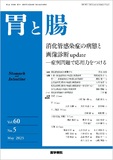Japanese
English
- 有料閲覧
- Abstract 文献概要
- 1ページ目 Look Inside
- 参考文献 Reference
要旨●急性感染性腸炎は,病態と罹患部位に基づき,小腸型,大腸型,穿通型に分類できる.小腸型の罹患部位は十二指腸〜空腸である.小腸型は非炎症型で,微生物や毒素による腸管からの分泌亢進であり,大量の水様性下痢を生じる.組織の破壊を伴わないため,発熱や腹痛はあっても軽度である.大腸型の罹患部位は大腸または下部回腸である.大腸型は炎症型で,微生物や毒素による組織侵襲による炎症のため滲出性下痢を生じる.組織の破壊を伴うため,発熱,腹痛,血便,粘液便,テネスムスなどの症状を呈する.穿通型の罹患部位は回盲部であり,消化器症状よりも発熱,菌血症などの全身症状が主であり,下痢はないこともある.問診で大腸型が疑われる場合や,血便がある場合などでは,腹部CTや下部消化管内視鏡検査を行うことで,原因微生物をさらに絞り込むことができる.画像は病態を反映しており,病態を踏まえて特徴的なCT像や内視鏡像を理解する必要がある.
Infectious enterocolitis is classified into small-intestinal, large-intestinal, and penetrating types based on pathophysiology and the affected intestinal region. In the small-intestinal type, the affected region extends from the duodenum to the jejunum. This type leads to excessive watery diarrhea caused by microorganisms or toxins that trigger hypersecretion. Because it does not involve tissue destruction, fever and abdominal pain are mild, if present. The large-intestinal type affects the large intestine or lower ileum. Exudative diarrhea occurs due to inflammation triggered by the invasion of microorganisms and toxins into the tissue. Because tissue destruction is involved, symptoms such as fever, abdominal pain, bloody stool, mucous stool, and tenesmus are observed. In the penetrating type, the ileocecal region is affected. This condition is termed penetrating type because systemic symptoms such as fever and bacteremia occur more frequently than gastrointestinal symptoms. The penetrating type may not cause diarrhea. If the large-intestinal type is suspected or bloody stool is present, abdominal computed tomography(CT)and colonoscopy can help identify the causative microorganism. Imaging findings reflect the pathophysiology ; thus, characteristic CT and colonoscopic images must be interpreted accordingly.

Copyright © 2025, Igaku-Shoin Ltd. All rights reserved.


